Platinum supply and demand are price inelastic in the short-term, leading to sustained market imbalances
26 June 2025
Platinum prices have increased by 55% year-to-date to reach a 10-year high. Historic data indicates that both platinum supply and platinum demand are price inelastic over the short term. Accordingly, we see limited risk that either respond to higher prices over the remainder of 2025f, with a market deficit expected to reach 966 koz.
Following a prolonged period of rangebound pricing (~$900-$1,100/oz), platinum surpassed $1,330/oz as of 18 June, marking its highest level since 2014. Despite this rally, we do not anticipate any meaningful supply or demand response in the near-term. Our May 2025 Platinum Quarterly (link) forecast a -4% year-on-year reduction in both total platinum supply and demand in 2025, and this view remains unchanged.
Figure 1 illustrates that historical movements in the platinum price have not triggered an immediate change in supply or demand, with responses often lagging by several years. On the supply side, platinum’s inelasticity is structural. Around 85% of platinum is mined as part of broader PGM operations. Whilst platinum is generally the largest revenue constituent of a PGM mine, new production decisions hinge on expectations of the overall basket including base metal by-products. Notably, an 83% surge in the basket price between 2017 and 2023 had no impact on total supply, which actually declined 7% over the same period (Fig. 2). Even sharp price signals take years to translate into new supply - most mines require 8-9 years to reach full production capacity, if they do so at all (Fig. 3). Recycling is more responsive to prices, but these ounces are small in the context of total supply (Fig. 4). Automotive recycling increased ~50% from 2015 to 2021 and decreased to 2023 as prices rose and fell (Fig. 5).
Fig 1. Platinum supply and demand have historically shown little short-term sensitivity to price movements
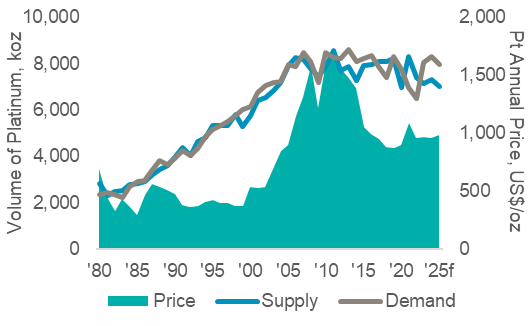
Fig 2. Despite sharp price increases, the PGM basket has failed to drive any meaningful gains in overall supply
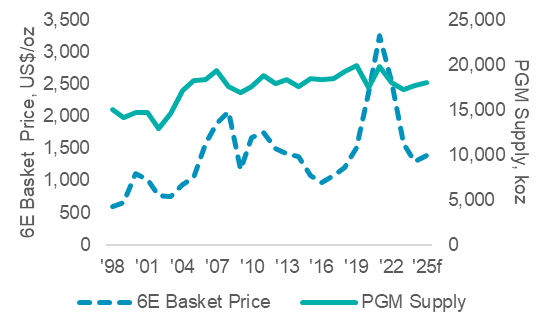
Demand is also unlikely to fall in the short-term despite the price rally. Across the automotive, jewellery, industrial and investment sectors, platinum consumption has historically shown limited price sensitivity (Fig. 6). Between 2003 and 2008, for instance, autocatalyst demand rose by over 25% even as prices climbed from ~$600 to ~$2,000/oz, only falling after the global financial crisis prompted a broader downturn and substitution to lower-priced palladium (Fig. 7). Industrial demand has shown some delayed inverse relationship with price, but volumes tend to adjust over multiple years rather than on a quarterly timescale. Jewellery is structurally more elastic, yet platinum’s relatively more attractive affordability versus gold is now emerging as a counterforce. The gold-to-platinum price ratio reached 3.5x in May 2025, its highest level since 2015, prompting some Chinese fabricators to switch to platinum (Fig. 8). These persistent demand patterns and supply rigidity reinforce continued platinum market deficits through 2029, as outlined in our recent 5-year outlook (link).
Platinum’s attraction as an investment asset arises from:
- WPIC research indicates that the platinum market entered a period of consecutive supply deficits from 2023 and these are expected to fully deplete above ground stocks by 2029f
- Platinum supply remains challenged, both in terms of primary mining and secondary recycling supply
- Elevated lease rates and OTC London backwardation highlight tight market conditions
- Platinum is a critical mineral in the global energy transition underpinning a key role in the hydrogen economy
- The platinum price remains historically undervalued and significantly below the price of gold
Figure 3: Long lead times, upfront capex requirements and technical challenges delay or prevent new PGM production even when prices are supportive

Figure 4: Recycling supply makes up a small proportion of total 3E supply
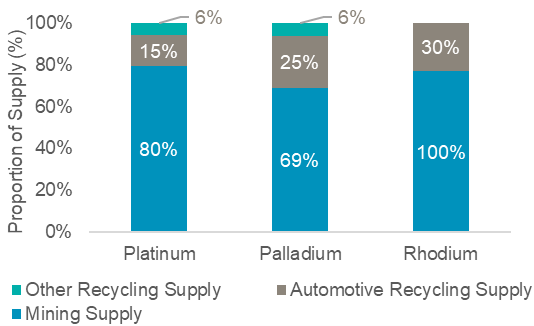
Figure 5: Between 2015 and 2021, the rise in basket price prompted an increase in 3E automotive recycling supply, but the impact on total supply was limited
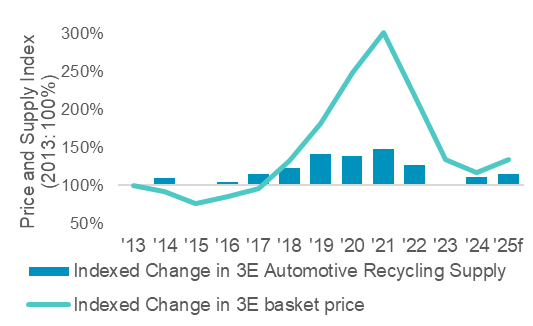
Figure 6: Demand across platinum’s major end-use sectors shows limited short-run price sensitivity
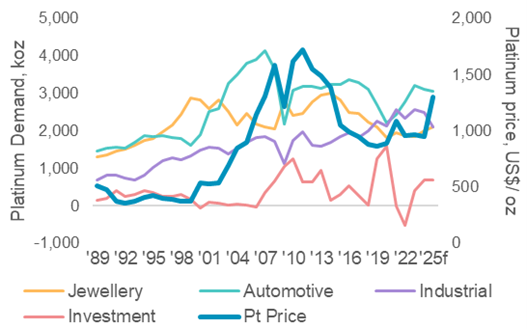
Figure 7: Autocatalyst substitution patterns reflect structural rather than short-term price dynamics

Figure 8: Rising gold prices led some Chinese fabricators to switch to platinum with buyers being priced out of gold
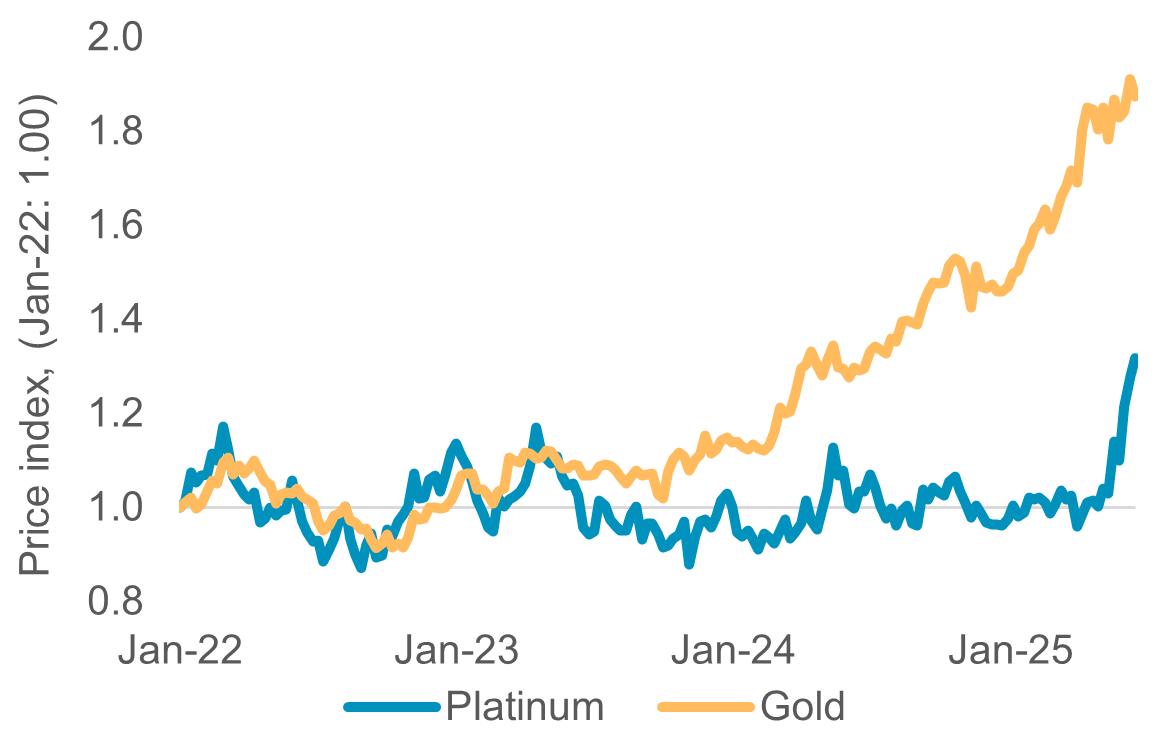
IMPORTANT NOTICE AND DISCLAIMER: This publication is general and solely for educational purposes. The publisher, The World Platinum Investment Council, has been formed by the world’s leading platinum producers to develop the market for platinum investment demand. Its mission is to stimulate investor demand for physical platinum through both actionable insights and targeted development: providing investors with the information to support informed decisions regarding platinum; working with financial institutions and market participants to develop products and channels that investors need.
This publication is not, and should not be construed to be, an offer to sell or a solicitation of an offer to buy any security. With this publication, the publisher does not intend to transmit any order for, arrange for, advise on, act as agent in relation to, or otherwise facilitate any transaction involving securities or commodities regardless of whether such are otherwise referenced in it. This publication is not intended to provide tax, legal, or investment advice and nothing in it should be construed as a recommendation to buy, sell, or hold any investment or security or to engage in any investment strategy or transaction. The publisher is not, and does not purport to be, a broker-dealer, a registered investment advisor, or otherwise registered under the laws of the United States or the United Kingdom, including under the Financial Services and Markets Act 2000 or Senior Managers and Certifications Regime or by the Financial Conduct Authority.
This publication is not, and should not be construed to be, personalized investment advice directed to or appropriate for any particular investor. Any investment should be made only after consulting a professional investment advisor. You are solely responsible for determining whether any investment, investment strategy, security or related transaction is appropriate for you based on your investment objectives, financial circumstances and risk tolerance. You should consult your business, legal, tax or accounting advisors regarding your specific business, legal or tax situation or circumstances.
The information on which this publication is based is believed to be reliable. Nevertheless, the publisher cannot guarantee the accuracy or completeness of the information. This publication contains forward-looking statements, including statements regarding expected continual growth of the industry. The publisher notes that statements contained in the publication that look forward in time, which include everything other than historical information, involve risks and uncertainties that may affect actual results. The logos, services marks and trademarks of the World Platinum Investment Council are owned exclusively by it. All other trademarks used in this publication are the property of their respective trademark holders. The publisher is not affiliated, connected, or associated with, and is not sponsored, approved, or originated by, the trademark holders unless otherwise stated. No claim is made by the publisher to any rights in any third-party trademarks
WPIC Research MiFID II Status
The World Platinum Investment Council -WPIC- has undertaken an internal and external review of its content and services for MiFID II. As a result, WPIC highlights the following to the recipients of its research services, and their Compliance/Legal departments:
WPIC research content falls clearly within the Minor Non-Monetary Benefit Category and can continue to be consumed by all asset managers free of charge. WPIC research can be freely shared across investment organisations.
- WPIC does not conduct any financial instrument execution business. WPIC does not have any market making, sales trading, trading or share dealing activity. (No possible inducement).
- WPIC content is disseminated widely and made available to all interested parties through a range of different channels, therefore qualifying as a “Minor Non-Monetary Benefit” under MiFID II (ESMA/FCA/AMF). WPIC research is made freely available through the WPIC website. WPIC does not have any permissioning requirements on research aggregation platforms.
- WPIC does not, and will not seek, any payment from consumers of our research services. WPIC makes it clear to institutional investors that it does not seek payment from them for our freely available content.
More detailed information is available on the WPIC website:
https://www.platinuminvestment.com/investment-research/mifid-ii
Contacts:
Edward Sterck, Research, [email protected]
Wade Napier, Research, [email protected]
Kaitlin Fitzpatrick-Spacey, Research, [email protected]
Brendan Clifford, Head of Institutional Distribution, [email protected]
WPIC does not provide investment advice.
Please see disclaimer for more information.
